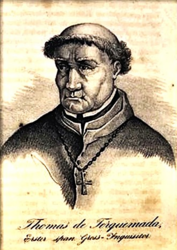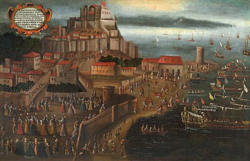
The Spanish Inquisition was a judicial branch of the Roman Catholic Church that was established in Spain in 1478 to prosecute heretics and non-Christians in the country, specially the today-called Sephardic Jews. It was originally established to clear the country of Muslims and Jews in the context of the final stages of the Christian Reconquista of southern Spain in the late fifteenth century. The goal was to either drive these same non-Christians out of Spain, most likely across the Straits of Gibraltar to Muslim North Africa or to force mass conversions to Christianity, particularly in the latter instance amongst the Jewish community. The Inquisition was engaged in this activity throughout the late fifteenth century, the entirety of the sixteenth century, and into the early seventeenth century, although its remit expanded from the late 1510s onwards as the advent of the Protestant Reformation increased the incidences of alleged Christian heresy in Spain and other territories controlled by the Spanish crown. The Inquisition led to mass migration in the shape of voluntary departures from Spain of Jews and Muslims to avoid persecution and forced mass expulsions which were enforced by the Inquisition and the Spanish government. It is estimated that this activity saw over three million people migrating from Spain between the late fifteenth century and the early seventeenth century.[1]
Chronology of eventsChronology of events

The Spanish Inquisition, the formal name of which was the Tribunal of the Holy Office of the Inquisition, was established in 1478 by Queen Isabella of Castile and King Ferdinand of Aragon, the joint rulers of what was soon to become the unified Kingdom of Spain. The Inquisition was initially established, with Fray Tomás de Torquemada as its first Grand Inquisitor, to deal with the growing number of non-Christians who lived within the lands of Castile in particular. These included some 300,000 Sephardic Jews and would eventually also include millions of Moriscos or Spanish Muslims. All of this was a legacy of the medieval history of the Iberian Peninsula, which in the eighth century had been almost entirely conquered and colonized by the Muslims Berbers and Arabs of North Africa. The Christian kingdoms of the north had gradually pushed the Muslims southwards, but the Reconquista (Reconquest) took over 650 years to complete and when it was finally achieved, when Isabella and Ferdinand conquered the emirate of Granada in southern Spain in 1492, it left huge numbers of Muslims across the country.[2]
While the Inquisition had been trying to make Muslims and Jews in Spain convert from 1478 onwards, it was really in 1492 that the major push to create a ‘pure’ Christian kingdom was initiated. No sooner had Granada been conquered that year, but the most Catholic monarchs, as Isabella and Ferdinand became known, issued the Alhambra Decree, which ordered that all of the kingdom’s Jews would either have to convert to Christianity, leave the country, or face summary execution. This mimicked similar expulsion measures which had been imposed against the Jews of England[3] and France[4] in the thirteenth and fourteenth centuries. In the end, it is estimated that upwards of 100,000 Jews were expelled in the months and years that followed from Spain. Approximately 200,000 converted and became known as conversos, but many did so only on the surface and continued to practice Judaism in private, though the Inquisition sought after and persecuted those who did for decades to come.[5]
The Inquisition was also responsible for trying to pressure the millions of Muslim Moriscos who inhabited the south of Spain and the coastal regions north towards Alicante and Valencia in particular to leave the country or convert. Many did indeed leave, with a large wave of migration occurring in the 1490s after the fall of Granada and further departures across the sixteenth century. From the late 1510s onwards the Inquisition's energies were absorbed elsewhere as the Protestant Reformation began and the main concern became the possible spread of Christian heresy into Spain. Nevertheless, intermittent efforts to expel the Moriscos occurred, notably under Philip II in the late 1560s. Then, in the early seventeenth century, Philip III and his government, led by the Duke of Lerma, became intent on ridding the country of the last of the Moriscos. Accordingly, an expulsion decree, similar to that which had been passed against the Jews all the way back in 1492, was passed against Spanish Muslims in 1609. Because there were hundreds of thousands of Moriscos to expel, the process would take over half a decade, but by 1614 it was deemed to be complete.[6]
Extent of migrationExtent of migration

The extent of the migration which occurred as a result of the activities of the Inquisition and the Spanish government is a matter of considerable conjecture, as there were few accurate demographic records kept during this time. However, most scholars agree that there were probably at least three million expulsions and voluntary migrations, with nearly 95% being Moriscos or Moors, who were Muslims and left over a very wide time span. For instance, there was a large wave of migrants who left either voluntarily or as a result of various types of economic and political coercion in the mid-1490s following the completion of the Reconquista with the fall of Granada.[7]
A steady flow of migrants continued to leave through the sixteenth century, while another huge wave left between 1609 and 1614 following the expulsion decree passed by King Philip III in 1609. This latter expulsion is believed to have resulted in the departure of anywhere between 300,000 and half a million Moriscos from Spain.[8] The Jewish migration was more isolated to the mid-1490s following the passage of the Alhambra Decree in 1492; out of an estimated 300,000 Sephardic Jews in the country at the time, it is agreed that somewhere between 50,000 and 120,000 Jews left the country, while the other 200,000 or so made surface conversions to Christianity.[9]
Demographic impactDemographic impact
The demographic impact of the expulsions and departures was felt in various parts of Europe and North Africa. The most impacted regions were Morocco, Algeria and Tunisia, which were the closest regions to Spain and required only a short trip across the Straits of Gibraltar for the Moriscos to go and live amongst their co-religionists with whom they shared many cultural traits. Cities like Oran and Tunis were particular hubs of Morisco resettlement. Others migrated further to the east to live in the lands of the Ottoman Empire, the rising Muslim power of the Eastern Mediterranean with which Spain was involved in an intermittent war for control of regions like Tunis and Malta over the course of the sixteenth century.[10]
Many Jews also left for Ottoman territory as rulers of the Turks such as Mehmed the Conqueror (r. 1451–1481) and Bayezid II (r. 1481–1512) made it known that they welcomed Jewish resettlement in their territories, as they valued Jewish abilities as skilled artisans, bankers, and merchants. Thessaloniki in northern Greece (known then as Salonica) became a particular hub for Sephardic Jews expelled from Spain. This endured down to the twentieth century to the extent that Salonica became known as la madre de Israel (the mother of Israel).[11] Some of the Jews who were expelled from Spain also drifted to Eastern Europe, the center of Ashkenazic Jewry in Europe since the Jews had been expelled from England, France, and other countries in the thirteenth and fourteenth centuries. There they formed part of the largest community of the Jewish diaspora worldwide until World War II and the subsequent emergence of the state of Israel.[12]
See alsoSee also
Explore more about the Spanish InquisitionExplore more about the Spanish Inquisition
- Spanish historical records on MyHeritage
- Portuguese historical records on MyHeritage
- How to Find Out If You Ancestors Were Conversos, article by Daniella Levy on the MyHeritage Knowledge Base
References
- ↑ What Was the Spanish Inquisition? TheCollector
- ↑ Reconquest of Spain. History Channel
- ↑ Jews in England 1290. The National Archives
- ↑ Schwarzfuchs, Simon R. The Expulsion of the Jews from France (1306). The Jewish Quarterly Review, Vol. 57, The Seventy-Fifth Anniversary Volume of the Jewish Quarterly Review (1967), pp. 482-489
- ↑ Modern Jewish History: The Spanish Expulsion (1492). Jewish Virtual Library
- ↑ Expulsion of the Muslims from Spain. EGO | European History Online
- ↑ The Purging of Muslim Spain. History Today
- ↑ Amelang, James S. The expulsion of the Moriscos, 1609–14. Migrants shaping Europe, past and present. Manchester University Press, 2022
- ↑ Expelled from Spain: July 31, 1492. Exploring Hate. PBS
- ↑ Villanueva Zubizarreta, Olatz . The Moriscos in Tunisia. The Medieval and Early Modern Iberian World, Volume: 56. 2014
- ↑ https://www.jewishvirtuallibrary.org/salonika
- ↑ Brook, Kevin A. THE ORIGINS OF EAST EUROPEAN JEWS. Russian History, Vol. 30, No. 1/2 (SPRING-SUMMER 2003 / PRINTEMPS-ÉTÉ 2003), pp. 1-22